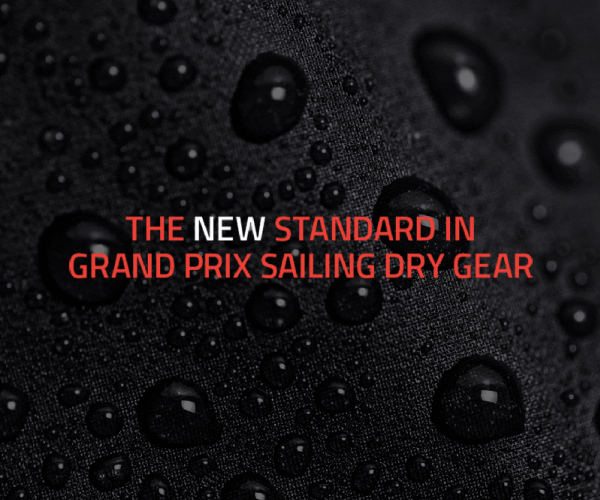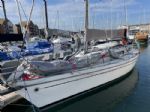





-(1)-202408140552.gif)






| Laser 140101 Tynemouth |
 |
| Rossiter Pintail Mortagne sur Gironde, near Bordeaux |
 |
| Laser 28 - Excellent example of this great design Hamble le rice |
 |
List classes of boat for sale |
Proper Course |
Post Reply 
|
Page <1234> |
| Author | ||
Guests 
Guest Group 
|
 Post Options Post Options
 Quote Quote  Reply Reply
 Topic: Proper Course Topic: Proper CoursePosted: 27 Feb 08 at 3:13pm |
|
Surely that's the key, so rule 18 still applies. |
||
 |
||
gordon 
Really should get out more 
Joined: 07 Sep 04 Online Status: Offline Posts: 1037 |
 Post Options Post Options
 Quote Quote  Reply Reply
 Posted: 27 Feb 08 at 3:19pm Posted: 27 Feb 08 at 3:19pm |
|
|
Spyderman,
We are talking about a gybe mark. At such a mark the outside overlapped boat before rounding is the windward keep clear boat. She must keep clear throughout the rounding. After both boats have gybed the outside boat is now the leeward right of way boat. She HAS acquired right of way. Rule 15 may apply Gordon |
||
|
Gordon
|
||
 |
||
iansmithofotley 
Far too distracted from work 
Joined: 16 Mar 04 Location: Otley, West Yorkshire Online Status: Offline Posts: 209 |
 Post Options Post Options
 Quote Quote  Reply Reply
 Posted: 27 Feb 08 at 8:13pm Posted: 27 Feb 08 at 8:13pm |
|
|
Hi everyone, It just shows how complicated the rules are as many experienced sailors have responded to this topic having had access to rule books and lots of time to think about the scenario. After all this consideration there is still quite a bit of disagreement and lots of different opinions. Nevertheless, whilst racing, we all have to make decisions like this in split seconds, often in strong winds, in testing conditions, when surrounded by many other boats (often of all different types with different sail plans) and in testing high performance boats. I think that the topic has been a great source of learning for us all. Redback said in his original post that the matter was resolved informally and in good spirit, which is great. I think that part of the problem, now that we have all had chance to study the situation, is that we really needed more information to decide which rules apply. I realise that initially it was just a brief, interesting, post by Redback who I suspect might be quite surprised with the amount of interest in the topic. However, situations like this happen all the time in club racing, open meetings and championships. I think that the problem has become more prevalent since the glut of asymmetric boats over the past fifteen years and particularly with asymmetric boats sailing against non-asymmetric boats. The ‘proper course’ problem raises its head all of the time. It seems that both boats were on tightish reaches, prior to approaching the mark in question, as neither boat was flying a kite. It appears that the leg of the course after rounding the mark was much broader, or a run, as both boats intended to hoist kites. It does not state whether or not the boats were clear ahead/astern on approaching the two length zone of the mark. It does not state whether or not the boats were within the two length zone of each other, or, if they were, at what stage in relation to the mark (before, alongside or past the mark). It does not state where the boats were in relation to the mark when the leading boat started to hoist a kite (before, alongside or after the mark). It does not state whether or not both boats had completely rounded the mark and were then on the downwind leg. My point is that unless these facts are known then it is difficult to assess which rules apply and when. Redback has not stated what type of boat he was sailing or what stage he was at, in the process of hoisting his kite. In my experience, if the leading boat was say a Musto Skiff or an RS 700, and the wind was say a Force 3+, then the helm would find great difficulty in pointing up, and keeping clear, in response to a luff from the outside boat, whilst in the process of hoisting his kite, knowing full well that there might be a strong possibility of a capsize if he did luff up. Rightly or wrongly, I suspect that he would, firstly, concentrate on safely getting his kite up and secured before getting out on the wire and then pointing up. The circumstances would be different in lighter winds. I can’t see how the topic can be finally resolved, with a definitive conclusion, as we, unfortunately, do not have all of the facts. It shows how important it is, if there is an incident, to know exactly where you are in relation to other boats concerned, in relation to marks, and precise details of relative distances involved. Problems will always occur if the parties involved do not agree or can not remember exactly where an incident took place. If an incident is not informally resolved and one or both of the parties accepts a penalty, this is where witnesses are important, particularly in cases where there is a formal protest which eventually goes to a Protest Committee for a decision. Ian (Yorkshire Dales S.C.) |
||
 |
||
Scooby_simon 
Really should get out more 
Joined: 02 Apr 04 Location: United Kingdom Online Status: Offline Posts: 2415 |
 Post Options Post Options
 Quote Quote  Reply Reply
 Posted: 27 Feb 08 at 9:54pm Posted: 27 Feb 08 at 9:54pm |
|
Excellent post Ian. Sums up why this is so difficult to do on a forum. |
||
|
Wanna learn to Ski - PM me..
|
||
 |
||
redback 
Really should get out more 

Joined: 16 Mar 04 Location: Tunbridge Wells Online Status: Offline Posts: 1502 |
 Post Options Post Options
 Quote Quote  Reply Reply
 Posted: 28 Feb 08 at 12:12am Posted: 28 Feb 08 at 12:12am |
|
|
I've just seen these posts. It's late but tommorrow I'll try and give you a sketch.
|
||
 |
||
Spyderman 
Newbie 
Joined: 27 Feb 08 Location: Netherlands Online Status: Offline Posts: 39 |
 Post Options Post Options
 Quote Quote  Reply Reply
 Posted: 28 Feb 08 at 12:23am Posted: 28 Feb 08 at 12:23am |
|
Perhaps a picture-diagram of the situation would help? Edited by Spyderman |
||
|
Are you interested in the Racing Rules of Sailing? Go to: http://rrsstudy.blogspot.com
|
||
 |
||
Spyderman 
Newbie 
Joined: 27 Feb 08 Location: Netherlands Online Status: Offline Posts: 39 |
 Post Options Post Options
 Quote Quote  Reply Reply
 Posted: 28 Feb 08 at 12:48am Posted: 28 Feb 08 at 12:48am |
|
My mistake. In this scenario you are right about the outside boat getting r-o-w and rule 15 is applicable. Specially since the overlap seems to be created by sticking out the kite-pole forward. However, if at that moment the windward boat was keeping clear and the contact only occurred because she bore off, rule 15 was not infringed. The windward boat could have kept clear. So, Leeward gave her room to do that... |
||
|
Are you interested in the Racing Rules of Sailing? Go to: http://rrsstudy.blogspot.com
|
||
 |
||
gordon 
Really should get out more 
Joined: 07 Sep 04 Online Status: Offline Posts: 1037 |
 Post Options Post Options
 Quote Quote  Reply Reply
 Posted: 28 Feb 08 at 5:07pm Posted: 28 Feb 08 at 5:07pm |
|
|
Judging from TSS (wish I could figure how to stop it moving), which I will take as the "facts found"
at 1 Blue is clear astern. Rule 18.2c applies and Blue must keep clear. at 4 : Blue has yet to finsh rounding the mark. 18.2c still applies and Blue must keep clear. At this point Blue is still clear astern at 5 The mark rounding is complete. Rule 18 no longer applies. Blue establishes an overlap from clear astern, partly, at least, because Yellow bears away to hoist her kite. Rule 15 does not apply. However Blue alters course, and, as right of way boat, is required to give room for Yellow to keep clear (rule 16.1). Contact is almost immediate. If Blue had not changed course, Yellow would have had an opportunity to keep clear. Blue has infringed rule 16.1 and should take a penalty. It would be interesting to know if the boats courses at 6 are in fact their proper course. If this is so then Blue would also have infringed rule 17.1 by sailing above her proper course at 5 Many competitors, especially in match racing, feel that rule 16.1 gives the keep clear boat an advantage as she effetively prevents the right of way boat from changing course. But that is the way the rules are written Gordon |
||
|
Gordon
|
||
 |
||
Stefan Lloyd 
Really should get out more 
Joined: 03 Aug 04 Online Status: Offline Posts: 1599 |
 Post Options Post Options
 Quote Quote  Reply Reply
 Posted: 28 Feb 08 at 6:51pm Posted: 28 Feb 08 at 6:51pm |
|
|
In the verbal description at the top of this thread, my reading is that Blue does not alter course. The animation does seem to show Blue luffing following the rounding but I'm uncertain if that is accurate. Why would Blue want to luff at this point?
|
||
 |
||
Spyderman 
Newbie 
Joined: 27 Feb 08 Location: Netherlands Online Status: Offline Posts: 39 |
 Post Options Post Options
 Quote Quote  Reply Reply
 Posted: 28 Feb 08 at 7:03pm Posted: 28 Feb 08 at 7:03pm |
|
The TSS diagram is a representation of how I thought the facts were. However the only one who can accuratly draw this is Redback I don't know where the next mark was situated, I don't know if Blue luffed.....or not |
||
|
Are you interested in the Racing Rules of Sailing? Go to: http://rrsstudy.blogspot.com
|
||
 |
||
Post Reply 
|
Page <1234> |
| Forum Jump | Forum Permissions  You cannot post new topics in this forum You cannot reply to topics in this forum You cannot delete your posts in this forum You cannot edit your posts in this forum You cannot create polls in this forum You cannot vote in polls in this forum |
Copyright ©2001-2010 Web Wiz
Change your personal settings, or read our privacy policy











 Printable Version
Printable Version Delicious
Delicious Digg
Digg Facebook
Facebook Furl
Furl Google
Google MySpace
MySpace Newsvine
Newsvine reddit
reddit StumbleUpon
StumbleUpon Twitter
Twitter Windows Live
Windows Live Yahoo Bookmarks
Yahoo Bookmarks Topic Options
Topic Options